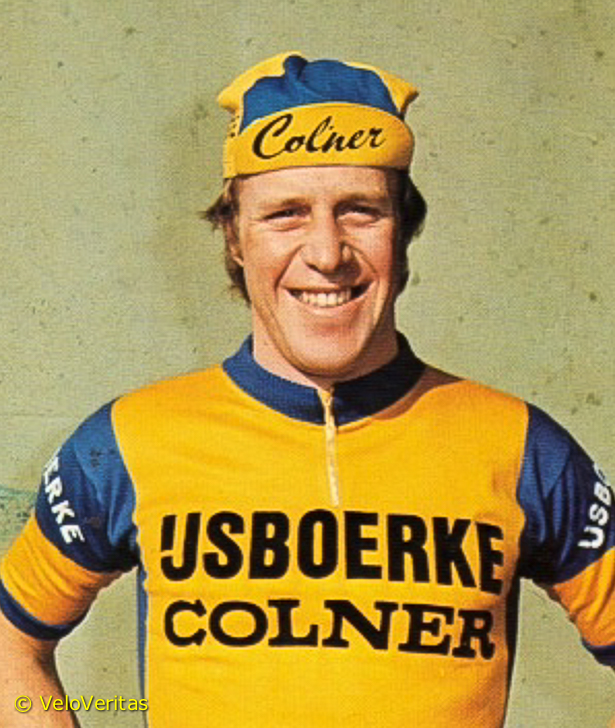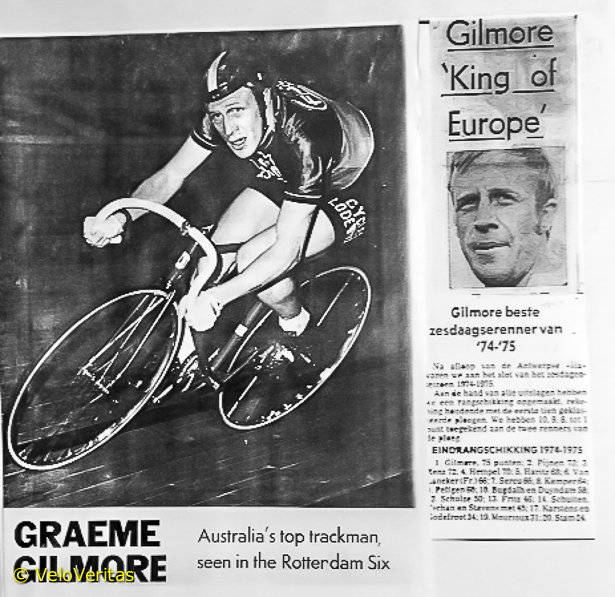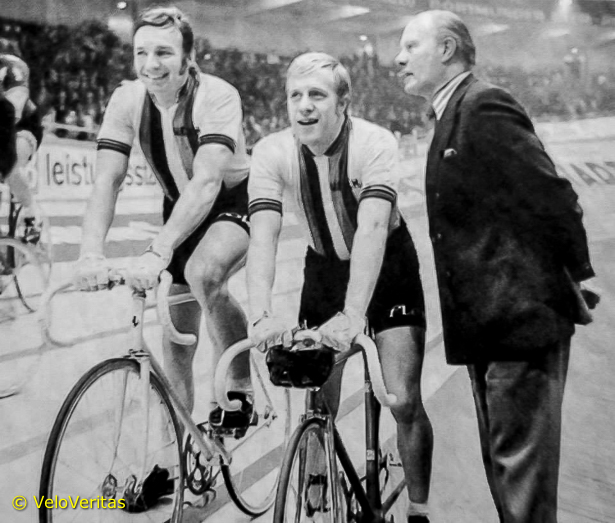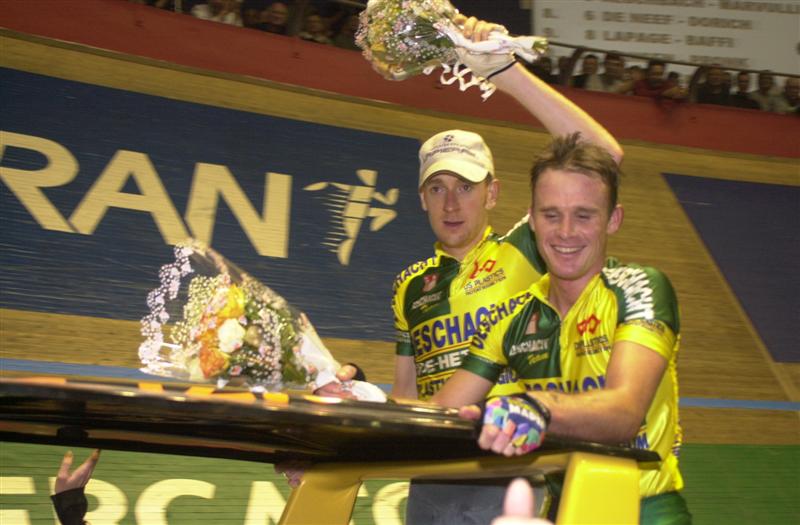
The Six Days of Amsterdam kicks off next week, the first race of the 2014/15 winter season.
The programme until Christmas makes sad reading with few ‘names’ in Amsterdam; tales of crooked promoters souring things there and in Rotterdam; possibly the last race in Grenoble – and it’s down to just three day; Zürich only four days and only Gent going from strength to strength.
After the turn of the year things improve with Rotterdam, Bremen, Berlin and Copenhagen all in good to robust health – but it’s a far cry from the 21 Six Days that winters in the 70’s enjoyed.
A stat which speaks louder than any words is that of the top 50 Six Day men of all time only one – Iljo Keisse – is currently active.
But this interview takes us back to the Golden Years of the 70’s and Merckx, Sercu, Clark, Allan, Renz, Bugdahl – and Graeme Gilmore.
Tell us about the ‘early days’ in Tasmania, please.
“I came from a strong cycling background where my great grandfather James was a cyclist in 1914 (his was career interrupted by World War 1), with my grandfather Albert (Jack) cycling in the 20/30s followed by my father Jack in 1940s with his career interrupted by World War 11 where he fought in New Guinea and Borneo against the Japanese.
“My brother Ken (18 months older) and I started racing in 1955 when I was 10 years old. I competed in the Juvenile ranks and won the B Grade club championships in the Launceston Amateur Cycling Club (under 12’S) on both road and track.
“Then followed that with A grade Juvenile champ again both road and track and also the 1mile Tasmanian Juvenile Champion (under 14’s). I progressed through the ranks winning the Tasmanian junior sprint, time trial and five mile scratch race (under 18’s) whilst still only 14.
“In those days there were distinct differences between amateur and professional cycling with the pros having the bigger classic races and money.
“I turned professional at 15 and in the years up to 1967 (when in March 1968 I left for Europe) I won all the major track and road classics in Australia.
“These included Australian Pro Elite Track and Road Championships in 1967 and first and fastest time in the Handicap Road Race Melbourne to Warrnambool (163 mile) where I gave away 65 minutes to the front markers.
“I also won the greatest Track Race, the “Tasmania Thousands” (One Mile Handicap at Devonport )beating Sid Patterson in the reputed World Record time of 1min 45.3 seconds – thus winning from one mile to 163 miles in the one year.
“My first Six Day race was in 1964 (at 18 years-old) when I partnered John Young to finish second; beaten on points by Waddell-Chapman in Launceston.
“In 1967 I won the Launceston Six with Sid Patterson as partner – these Six Days were open air with sessions from 9:00 am to 12:00 noon; 1:00 pm to 5:00 pm then 6:00 pm to midnight with the daylight racing under a hot Aussie sun.
“My initial coaches were my father Jack then Len Jamieson and Mac Sloane (both former pros).”
Is it true that you and Danny Clark lived in close proximity to each other?
“Yes true Danny lived in George Town which was 50 km away from Launceston – I never raced against Danny in Australia.”

What was your inspiration to come to Europe – did you come with the Six Days in mind?
“Sid Patterson was my inspiration to go to Europe; we rode Sixes together in Australia as well as being team-mates in the Malvern Star Team.
“He said I had the all round ability to ride the Six Days in Europe.
“I also had a very good gauge as well as many Europeans raced in these Australian Six Days, riders like Oscar Plattner, Dieter Kemper, Palle Lykke, Nando Terruzzi, Leandro Faggin and many others – and I held my ground against them.”
How did you get your first contract; tell us where, who with, how did you go?
“I arrived in Belgium April 1968 with a one way ticket to Europe (couldn’t afford a return just too expensive those days) and enough money I believed for six months but it actually turned out to be three months – so it was a sink or swim situation!
“I had really good form from Australia where I had done heaps of training and within five months of racing the kermises and getting results I had a road contract with Flandria DeClerck Kruger. The contract was a bike, clothing and the princely sum of 400 Belgian francs a month ($100 AUD).
“I had a one room apartment in Brevrijdingslaan in Gent, no bed, no furniture except for a sleeping bag, pillow, a knife & fork, plate, pot, pan and two gas burners. I slept on the floor for six months until I could afford furniture.
“Charly Ruys the promoter who re-started the London Six in Earls Court and then Wembley was also promoting criteriums in Holland at the time and he suggested that I, along with fellow Aussie Bill Lawrie compete in some trial madisons in London on the open track at Herne Hill.
“We won and were given a contract to race together in the London Six in September 1968.
“I had only two shilling and six pence in my pocket when I pulled up at the Wembley Track in an old Volkswagen – sink or swim. Bill and I finished fifth at two laps to Post-Sercu which was a good effort; plus we picked up many primes along the way.
“I beat Sercu (who was the world pro sprint champ at the time) for the BBC sprint series – a race within the Six – and this attracted the attention of Fons Versnick who was one of the rider managers for the velodromes in Europe, he offered me a contract to race in the Grand Prix Trofee of Wegrenners (Roadriders) in the Gent Sportpaleis as I was also reigning Australian Professional Road Race Champion.
“The race, against the national European road champions was an omnium (much to my liking) which I promptly won and secured a contract for the Gent Six with Romain DeLoof – we finished fifth.”
How long did it take you to gain acceptance with the ‘Blue Train?’
“It took four years apprenticeship until 1972 – my biggest break was teaming with Patrick Sercu in the Frankfurt Six where we finished third – but controlled the race – I think Patrick could see my potential.
“We were referred to that if Patrick was the axle of the “Blue Train” then I was the ball bearings – I can vouch for the fact that no presents were given or taken in this elite group; you had to earn your place.”
Who was your most impressive adversary?
“On the road Eddy Merckx (but I was not in his league anyway) and on the boards, Patrick Sercu (the best ever track rider – without question).
“Klaus Bugdahl and Sigi Renz were the ultimate Six Day team – they could sure hurt your legs in the chase.”

The stats please – how many Six Days started, finished, won, podiums?
“I rode 117 Sixes (when Six Days were actually run over six days) winning 13; 12 x 2nds; 20 x 3rds – 72 times in the first 5 with 51 different partners.
“I was European, Danish & Canadian Open Omnium Champion.
“And also the winner of the Grand Prix Sprints at Civitavecchia, Naples and Dortmund as well as track lap record holder at London, Berlin, Dortmund, Munich, Cologne, Bremen, Rotterdam, Los Angeles, Delhi and Gent.
“Then there was the 1974 Zürich track records madison with Klaus Bugdahl for 25/30/40/50 km averaging 57kph.
“And the 1974 Munich Track Record madison with Sigi Renz 100km in 1hr 55mins.
“You could say I was a bit of an all rounder from sprints to madisons to Six Days and a smattering of road.”
51 partners – who was your favourite?
“Yes, I had 51 Partners – much the pity I was the only English speaking rider continually riding Sixes which was a disadvantage, not having a “fixed” partner such as in later years a Don Allan-Danny Clark combo.
“Patrick Sercu and I were generally pulled apart as a team as the directors wanted to see us compete against one and other especially in sprinting.
“I rode mostly with the Germans Dieter Kemper, Klaus Bugdahl, Sigi Renz who I won most of my races with – but my favourite partner was the Belgian Julien Stevens, he would “bleed” and suffer for you no matter how hard the race got, an absolute true team mate.
“We were team mates on the road (Ijsboerke Colner) and on the track – in 1974 when we won the Gent Six together we were unbeaten in the Gent track all season winning four madisons.”
Which was your favourite – and least favourite race?
My Favourite was Zürich Six (unofficially recognised at the Six Day World Champs) – because of its palmarès and every night there was a classic event; an auto sprint (sprint for a car over 25 laps), a 100 minute madison, a madison behind Dernys – a lot of variety.
“Least favourite was the Berlin Sportpaleis (not the Deutschlandhalle) Berlin had two Sixes per year in the days gone by.
“The Sportpaleis had a low ceiling which trapped the smoke and shallow bankings which made it claustrophobic.”

How many different Six Day venues did you race at during your career?
“I raced at 36 different tracks over the years, including Australia.”
Which was the toughest – in terms of racing; and in terms of working conditions?
“The toughest Six was Zürich – just relentless races, speed (a very fast track) and prestige (everyone trying their hardest) when you got out of the Hallenstadion you knew you had ridden.”
Tell us about your bike – you were obviously very fastidious, recalling your words about your rear hub and bottom bracket axle…
“I had various bike manufacturers initially but settled on an Italian manufacturer in Milan, Lupo Mascheroni [who also built frames for Patrick Sercu, ed.]
“When we had the angles and measurements settled he made a jig especially for my frames so that when I re-ordered the frame was always exactly the same (I forget the degrees now) but the bikes were made more for sprinting than the typical laid-back seat tube of a Six Day bike.
“I sat 50mm behind the bracket from the front of the seat with an 11.5 cm stem and Cinelli 14 bars.
“The bottom bracket was machined narrow with a cut down axle so that cranks were right against the frame’s rear stays – that helped in riding slow on the bankings.”
Tell us about your road palmarès.
“Australia: Professional Road Race Champion, Winner Melbourne to Warnambool 163 mile Classic, won eight stages in the Herald Sun Tour, multiple one day race wins, the three day Tour of the Peninsular (three stage wins) second in on GC in the Herald Sun Tour over nine days.
“Europe: Winner Grote Prijs Westrozobeke- Belgium 1974 (solo by one minute) I believe the first Australian ever to win a pro road race in Belgium.
“Third In the last stage of Paris-Nice 1975 – Raymond Delisle won from Domingo Perurena in a breakaway and I won the sprint for third.
“The Tour of Limburg, fourth; Tour of Cologne, third; 32nd World Road Champs Zolder Belgium 1969; Winner criterium Waldenbach, Germany 1974; Winner Criterium Jetstten, Switzerland 1974; winner V&G Series Great Britain 1971.”

How did you stop from becoming stale when you raced summer and winter?
“I always rested when the big tours were on in June and July – climbing mountains and me didn’t mix.
“I was like most riders in my era you had to race to earn money – even Merckx, Altig, Gimondi etc. rode Sixes as well.”
Which was your last Six Day, why quit when you did?
“My Last Six Day was with Roger De Vlaeminck in Milan, sponsored by Brooklyn where we were third but won the biggest madison for the Citroen Cars.
“In Paris-Nice I had a very bad crash on the descent of the Col de Tanneron, badly lacerating my thigh and displacing my left knee which took a long time to recover from – and truth be known the continual riding over the years was starting to take a toll.
“There was one year I rode 17 Sixes in the season plus the road totalling around 42,000 kilometres and had been racing since I was 10 years-old so I retired in 1978 and went into business back in Australia.
“I think 23 years racing with 18 as a professional was a good innings.
“The Paris-Nice crash was a catalyst in developing osteoarthritis which lead to a double knee replacement but I can still pedal a bike.”
How did you feel when your son Matt decided he wanted to be a Six Day man?
“It was in the blood and he was strong-willed and had the talent – plus you support your kids with whatever they choose and he didn’t turn out too bad, either!”

What do you do now?
“I’m enjoying retirement with my beautiful wife Kay who I met and married in Belgium (three of our four children were born there) and without whom I wouldn’t have survived and achieved as much in Europe.
“I have been retired for six years after 29 years being General Manager of a Construction & Manufacturing Company.”
Do you still get out on the bike?
“Yes, four times a week just smelling the roses and I ride that slow I could pick them as well.”
Why do you think the Sixes have declined?
“Lack of talent and skill from the present day track riders, there’s no flair at the moment – they seem to ride like robots (both road & track).
“Track cycling to me has become too sanitised; if you touch someone nowadays they fall off or you get disqualified – unfortunately there are just not enough madisons or Sixes to hone skills.
“It’s not necessary for the road riders to ride the track these days as they have their designated programs and massive contracts; not like in the days of Eddy Merckx, who won 50 races on the road in a year and the Sixes in the winter to make his money – after all it is a professional sport.
“Talking to Patrick Sercu and Sigi Renz who ran the Munich Six until it stopped, the cost of renting the Velodrome for a Six is just too prohibitive now.
“So it’s a question of both, ie. lack of talent and rising costs – unfortunately the golden years have gone for the Sixes.”
Any career regrets?
“No!
“If I had to do it again I would do the same in a heartbeat – from sleeping on the floor in Gent in 1968 to being European Omnium Champ and the best Six Day rider in the world 1974/75 – my Dad said many years ago: Do your best in whatever you do and that will be good enough!”



